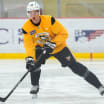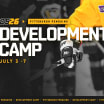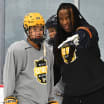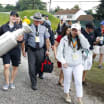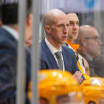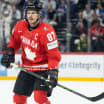PHILADELPHIA, Pa. - The Pens' biggest strength all season long has been their power play, which set a franchise record and led the entire NHL with a 26.2-percent success rate.
So when the unit went 1 for 8 in the opening two games of its First Round playoff series against Philadelphia, there was no panic inside the Pittsburgh locker room.
Pens' power play powers Game 3 win
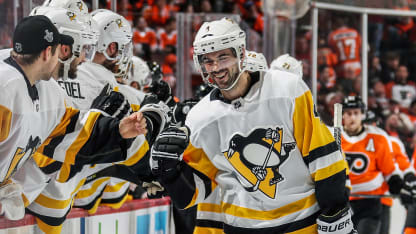
© Len Redkoles/Getty Images
By
Sam Kasan
NewJerseyDevils.com
"We know what we need to do," said center Evgeni Malkin before the game.
Knowing is half the battle. The other half is execution. The Pens put both ingredients together to connect for three power-play goals (in seven chances) in a 5-1 victory in Game 3 at Wells Fargo Center on Sunday afternoon to take a 2-1 series lead on the Flyers.
"It was good to win the special teams battle and it was a big part of our success," captain Sidney Crosby said.
And the answer to the team's woes was pretty simple: shots. A lot of shots.
"It was just a matter of time for our power play to connect," said center Derick Brassard, who scored the team's first power-play goal of the game. "There's no panic on our side. We knew we'd connect soon. We just established shots on the power play. After that there were open lanes and open seams."
The Flyers' PK was intent on taking two things away from the Pens' power play: Evgeni Malkin and Phil Kessel. It seems the game plan was to not let Malkin and his counterpart on the opposite circle, Kessel, beat them.
Whenever Malkin had the puck, the two closest Flyers converged to take away his low option (Crosby) and mid option (Patric Hornqvist). And the same was true when Kessel had the puck.
Philadelphia did an impressive job of that in Games 1 and 2, forcing Malkin and Kessel to retreat to their third option, which would be the high option (Justin Schultz or Kris Letang).
The Flyers were being aggressive on those edges, but leaving the middle lane open for the defensemen to shoot. Schultz told me after the game that if the Flyers are going to give the defenseman that look, they have to take it.
"We have good forwards so as much as we can get the puck down there for them to get those rebounds, we're going to try to do that," he said. "I thought we did a better job tonight. We have to keep improving on that."
I understand why Schultz and Letang want to work the puck to Malkin and Kessel, and let them make a play. Those are two dynamic talents that can create plays that no one else can see.
But with the Flyers again abandoned that middle lane from up high, Schultz and Letang had to buckle down and just take a shot.
That's exactly what both of those players did, and it resulted in a pair of goals.
"Smart shots and making sure we shoot the puck from the right areas and at the right time," head coach Mike Sullivan said of their strategy. "If the puck doesn't go in then maybe it creates an advantageous opportunity for us. Nothing breaks coverage down like a shot on goal because it forces decision on both sides. Our top players can take advantage of those decisions if they win that puck."
The first power-play goal of the night for Pittsburgh occurred because Letang took a shot. The Flyers scrambled on the rebound and the puck ended up on the stick of Kessel at the goal line. He found Brassard, who finished.
The Pens' second power-play goal came on a 4-on-3. So it wasn't quite the same setup, but Malkin buried a nasty one-timer from the top of the circle.
On the Pens' third power-play goal it was Schultz himself that would shoot andscore from the mid-point. He buried a heavy slap shot for his first of the playoffs.
But even on the power plays in which the Pens didn't score, the theme was the same: shots; shots; shots. The Pens had 26 shots in the game, 12 of which occurred with the man-advantage.
The Pens' power play can beat an opponent in many different ways. If you take away one thing, they'll beat you with another. And that's what the Flyers learned in Game 3. You can try to clog a hole, but Pittsburgh will find an opening and kick down the door.
"I thought the power play for the most part made good decision with their selection of when they were going to shoot and when they were going to remain patience and move the puck," Sullivan said. "We liked the areas of the rink that they were shooting from and creating opportunities for us."

